
Pictured is part of the inside of Lake Hoare- this shows about 1/5 of the main camp that includes the kitchen, radio area (shown), and computer area (3 computers connect us to the outside world).
We have 1 cubby per person to store our personal effects in- we keep everything else in our tents where we sleep. (Fortunately, we do not have to share tents.) We also try to hold onto one mug (dangling from the ceiling) for a day to lower the amount of grey (dirty water) we produce washing dishes.
Yesterday morning we didn't head up the glacier until 10 am. Heidi wasn't feeling well, so Rae hiked up with us (Hassan, Liz Bagshaw and me). Our mission- lowering the met station on the Upper Canada Gla
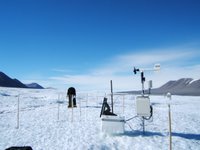 cier- because in 4 or 5 years its legs have melted out--- (wood legs are drilled into the glacier and the met station is set on top, over time the glacier losses mass via sublimation and the wooden legs are exposed, leaving the met station well above our heads- we reset the station on new drilled in legs). This required hammering and ice axing the old wooden pedastals out from the ice that they are frozen into, and carefully lowering the met station to the ice surface to reset new legs. The lower met station is pictured in this near surface position--- you can see what looks like an airplane with a fan on its snout- that instrument is used to determine wind direction and spped. Liz is measuring from the top of the stakes to the surface of the glacier to determine how much of the surface has disappeared (ablated) during the summer season
cier- because in 4 or 5 years its legs have melted out--- (wood legs are drilled into the glacier and the met station is set on top, over time the glacier losses mass via sublimation and the wooden legs are exposed, leaving the met station well above our heads- we reset the station on new drilled in legs). This required hammering and ice axing the old wooden pedastals out from the ice that they are frozen into, and carefully lowering the met station to the ice surface to reset new legs. The lower met station is pictured in this near surface position--- you can see what looks like an airplane with a fan on its snout- that instrument is used to determine wind direction and spped. Liz is measuring from the top of the stakes to the surface of the glacier to determine how much of the surface has disappeared (ablated) during the summer seasonAfter Liz and I helped lift the met station down, we cramponed are way down the crusty glacier ice to the lower
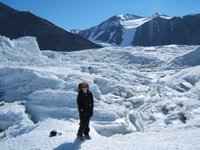 western most part of the Canada Glacier(pictured). The main supraglacial stream channel flows off the glacier just after this area. (The stream has cut into the glacier surface about 2 or 3 meters, which is much more deep than typical polar glacier supraglacial streams). In this deep channel we sampled with the clean suits on--- the site was particularly interesting because there was foam caught on some ice banking the fast-flowing stream--- it was definitely a sign of life- like the foam you see on the shores of many lakes in the hot summer. This microbial brew may be feeding on the metals in the water- at least that is my hypothesis.
western most part of the Canada Glacier(pictured). The main supraglacial stream channel flows off the glacier just after this area. (The stream has cut into the glacier surface about 2 or 3 meters, which is much more deep than typical polar glacier supraglacial streams). In this deep channel we sampled with the clean suits on--- the site was particularly interesting because there was foam caught on some ice banking the fast-flowing stream--- it was definitely a sign of life- like the foam you see on the shores of many lakes in the hot summer. This microbial brew may be feeding on the metals in the water- at least that is my hypothesis.Liz volunteered to be 'clean hands' and open the innermost bag of my triple bagged trace metal samples and take the sample. As 'dirty hands' I openned the outter two bags and wrote on
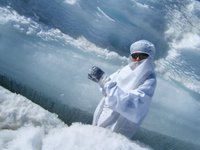 the bottle label, without getting my hands anywhere near the sample bottle. Liz has sampled this stream before, dubbed the 'Hollywood Bowl' for its magical glamour. And it is tricky to stand with your crampon foot pushed up on the side of the channel wall to avoild stepping into the fast stream--- I would not be injured misstepping into the stream, however, I would make the stream dirty and not be able to sample. I am posting a picture of Liz taking the Boron and Lithium samples we take after the trace metals (it is ok that the mask is loose during these samples). We had a great time walking up the hummocks and through the internal cliffs of the Canada Glacier back to the met station (pictured below)- samples in tow.
the bottle label, without getting my hands anywhere near the sample bottle. Liz has sampled this stream before, dubbed the 'Hollywood Bowl' for its magical glamour. And it is tricky to stand with your crampon foot pushed up on the side of the channel wall to avoild stepping into the fast stream--- I would not be injured misstepping into the stream, however, I would make the stream dirty and not be able to sample. I am posting a picture of Liz taking the Boron and Lithium samples we take after the trace metals (it is ok that the mask is loose during these samples). We had a great time walking up the hummocks and through the internal cliffs of the Canada Glacier back to the met station (pictured below)- samples in tow.
Today is another beautiful day--- and we have an interesting visitor- Patrick Leahy, the Director of the US Geological Survey will be here at 9. I am going to get in the lab and filter my non-trace metal samples before he arrives- say hello and then head up the glacier with Heidi to sample some cryoconite holes that have melted into the surface of the glacier. This place inspires good science.
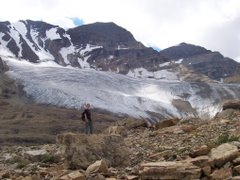
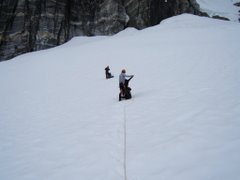

No comments:
Post a Comment